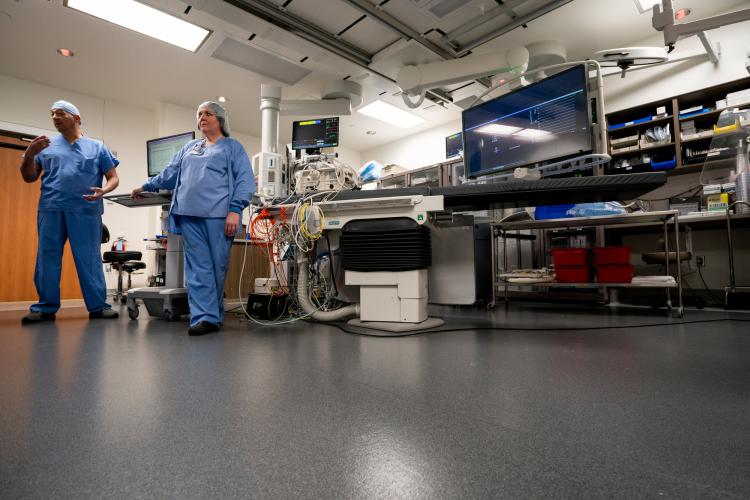
Rhythm is very important when it comes to the work of the heart. If the beat is off by even a little bit, it can cause of variety of problems for a patient including everything from a temporary loss of consciousness to a higher risk of death due to a heart attack or stroke.
Within the Invasive Labs Department at JPS Health Network lies the Electrophysiology Room – or EP Room for short. It’s a place where the “wiring” of the heart can be tested in effort to pin point the source of heart rhythm problems and, when the source is found, one of a number of procedures can be performed to eliminate it.
“It’s extremely rewarding when we can help a patient who came in very scared,” said Abel Flores, an Invasive Labs specialist at JPS. “They’re very thankful, so we can tell how much what we were able to do means to them.”
According to Amanda McDonald, Manager of Cardio Invasive Services, JPS opened its EP Room in October 2015 and about 130 procedures are performed in it annually. In many cases, a minimally invasive procedure with a catheter eliminates the need for open-heart surgery.
“It’s amazing that in the course of a couple of hours it can be determined exactly where the problem is within a person’s heart,” McDonald said. “And in many cases, in about the same amount of time, something that has been troubling a patient for months or years can be fixed like it was never there.”
Instead of having to open the patient’s chest to modify their heart, in the EP room team members can often make repairs through the use of a catheter which is inserted into the patient’s body through a small incision in their groin area. The catheter is then run through blood vessels up to the heart where it can perform vital work with pin-point accuracy.
Having a heart attack, aging and high blood pressure are the most common causes for scarring of the heart muscle that leads to a breakdown in the way its electrical impulses are delivered. But congenital heart defects can also be a cause, according to the American Heart Association.
Services of the EP Room include:
- Finding the cause of an abnormal heart rhythm, also known as an arrhythmia. If you've been diagnosed with an arrhythmia, such as atrial fibrillation, atrial flutter, tachycardia, ventricular tachycardia or supraventricular tachycardia, your doctor may ask for an EP study to better understand how electrical signals travel through your heart and learn how best to treat your condition. In an EP study, electrode catheters sends electrical signals to different parts of your heart and records how it reacts. According to the Texas Heart Institute in Houston, about 4 million people have heart arrhythmia.
- Cardiac ablation. When an EP study determines that a faulty electrical impulse is being created in a part of a patient’s heart, a cardiac ablation can be used to eliminate the problem. Heat or cold energy is used to create scar tissue in the heart which will block erratic signals and make the heart work as it’s supposed to. Not all people with an irregular heartbeat need ablation. Often, an EP study determines how the problem can be treated with medication.
- Implanting cardiac devices including pacemakers and internal defibrillators. These devices monitor the activity of the heart automatically and can take corrective action when needed. Electrodes in the pacemaker help the device determine if the heartbeat is abnormal and, if it is, electrical impulses can be sent to restore its beat. Similarly, the internal defibrillator monitors for ventricular tachycardia or fibrillation searches for irregular beats. But it detects sudden bursts of energy to the heart that cause it to beat too fast and corrects it with a burst of energy.
Michele Rouseau, RN Service Coordinator in the EP Room, said patients are often very sick and very scared when they come to Invasive Labs with a heart problem.
“Often, this is the last stop before surgery,” McDonald said. “Or it could be the last chance for the patient to get better. So, the team is determined to do whatever it takes to get the job done.”
